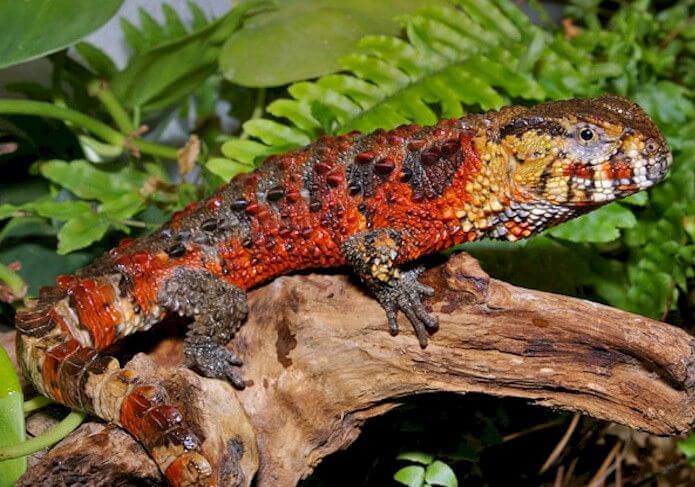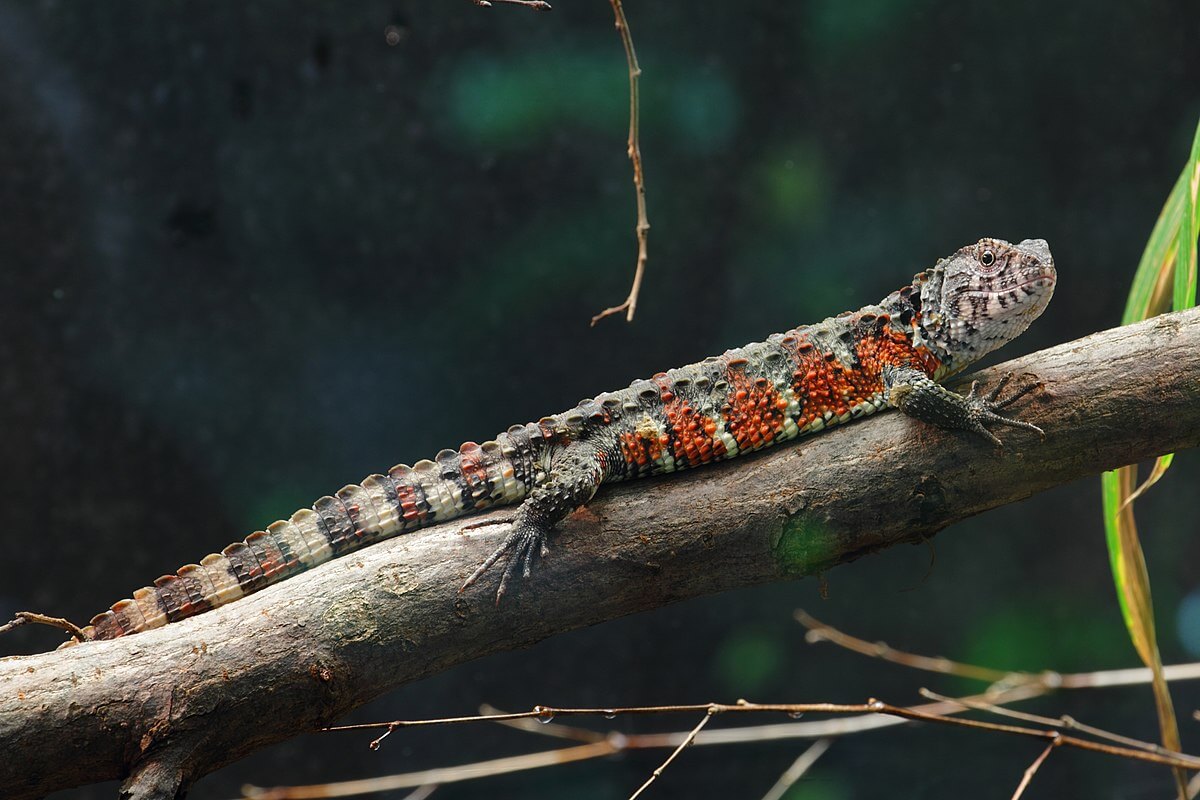The Chinese Crocodile Lizard: Habitat, Characteristics, and Curiosities

On our beautiful planet, we can find a wide variety of amazing animals. Among them, we have the Chinese crocodile lizard. A specimen that, although its common name includes the term crocodile, doesn’t belong to this group of animals. Rather, it’s a sauropsid with a scaly and colorful body. Do you want to know more about it?
Its scientific name is Shinisaurus crocodilurus, and it’s the only animal within the genus Shinisaurus and the family Shinisauridae. It’s recognized as a true “living fossil.” In this article, we’ll present you with all the details regarding this exotic reptile, so don’t miss its habitat, its characteristics, and some more interesting facts.
The Chinese crocodile lizard

This scaly lizard is native to China, in a small mountain range between China and Vietnam. However, it has a discontinuous distribution in this region. Its altitudinal range is variable, ranging from 650 to 4925 feet above sea level.
It inhabits tropical evergreen broadleaf forests. To be more precise, it lives in and around mountainous streams with slow stretches and dense vegetation, as it’s a semi-aquatic animal. In fact, it uses the branches overhanging the water bodies to hide and sleep.
The physical characteristics of the Chinese crocodile lizard
The Chinese crocodile lizard is an animal with a grayish-brown body color on its dorsal or upper part, while the ventral or lower part is more yellow. In addition, it presents certain details or intense red-orange spots in the throat region and the sides, which makes it quite eye-catching. Young specimens are usually dark brown in color but have a lighter head.
As for its size, it reaches between 8 and 16 feet inches in length and weighs between 7 and 10.5 ounces. Sexual dimorphism is also present, which means that the males and females are different regarding some of their characteristics. In this case, the male individual is larger and more colorful, especially during the breeding season.
The characteristic that stands out in this species is that it has two rows of scales along its tail. It’s this aspect that provides the similarity with a crocodile and from which it derives its common name.
The behavior of the crocodile lizard
These are diurnal animals with greater dynamism during the morning and afternoon hours. They’re also territorial, solitary, and semi-aquatic, so they can spend a lot of time in the water. In particular, if they feel in danger, they go to these spaces to take refuge. Longevity is around ten years in captive specimens. However, their life expectancy in the wild is unknown.
Chinese crocodile lizards are carnivorous animals with a diet based on invertebrates such as cockroaches, worms, lobsters, and crustaceans, among others. However, they also consume small fish and tadpoles. In captivity, they feed on snails, insects such as crickets, and certain worms. This is explained by the Smithsonian National Zoo.
Crocodile lizard reproduction
These specimens are viviparous, with a gestation period that lasts about nine months. They produce one litter per year, with a variable number of offspring between 2 and 12. Another interesting aspect of reproduction is that there’s no parental care, so the lizards are completely independent from birth. Likewise, as far as sexual maturity is concerned, we know that they reach it when they’re two years old.
Interesting facts regarding the Chinese crocodile lizard
These reptiles from China aren’t only beautiful, but there are also many interesting facts about their life that you’ll want to discover. Here are five of them.
They can spend long periods underwater
These animals have the ability to drastically reduce their respiratory rate. This aspect allows them to spend long periods of time underwater without coming up for air, with figures ranging from 15 to 20 minutes.
2. The colorful shades of the throat and belly are variable and have a meaning
This lizard has a wide variation of color in the throat and belly area and apparently has an important meaning. According to recent research published in the journal Biology in 2022, the color red functions in social communication and indicates individual quality. However, the information is different between sexes and body regions.
On the one hand, females with red bellies also have larger heads. However, those with more pigmented throats are endowed with greater bite force.
As for males, redder individuals are older. The colored throats in this sex have smaller heads and lower bite forces. However, redder bellies have better offspring, which live longer and are larger, than those that are less pigmented.
They’re known as “the lizard of great sleepiness” by locals
These reptiles often spend long periods of time immobile and out of the water when temperatures drop below 59 °F. This happens in a period similar to hibernation, in which they’re in a metabolic pause to conserve their energy. In this way, they manage to withstand extreme temperatures.
Furthermore, due to this aspect of inactivity, they’ve earned the name “the lizard of great sleepiness.” Likewise, it’s the basis for the belief that they’re animals that have the ability to cure insomnia.
4. They’re in danger of extinction

At present, crocodile lizard populations are in a declining state. For this reason, the International Union for Conservation of Nature (IUCN) lists them in the endangered category. The main threats include habitat loss due to deforestation and poaching for the pet trade. This is due to the attractiveness of these specimens.
5. There are two subspecies of crocodile lizards
The only living representative of the genus Shinisaurus, there are currently two subspecies, one from China (S. crocodilurus crocodilurus) and one from Vietnam (S. crocodilurus vietnamensis). Each has particular morphological, ecological, and molecular characteristics.
As you can see, the Chinese crocodile lizard is a strange and striking reptile because of its coloration and appearance. However, it also stands out for other aspects of its behavior, such as its metabolism. Therefore, it’s an exotic animal that’s worth learning about and protecting to ensure its survival.
All cited sources were thoroughly reviewed by our team to ensure their quality, reliability, currency, and validity. The bibliography of this article was considered reliable and of academic or scientific accuracy.
- Calvete, J., Lomonte, B., Lorente, C., Davinia, Michael, & Mebs, D. (2023). Proteomic analysis of the mandibular glands from the Chinese crocodile lizard, Shinisaurus crocodilurus – Another venomous lizard? Toxicon, 225, 107050. https://www.sciencedirect.com/science/article/pii/S0041010123000363
- Hanh, N., Benjamin, T., Jyoti, D., Quyen, D., Thanh, B., Tien, P., Truong, N, Ziegler, T., & Minh, L.. (2021). A survival blueprint for the Vietnamese crocodile lizard, Shinisaurus crocodilurus vietnamensis, an output from EDGE fellowship, Zoological Society of London. https://www.edgeofexistence.org/wp-content/uploads/2018/04/Survival_Blueprint_2021_Crocodilelizard_Vietnam.pdf
- Nguyen, T.Q., Hamilton, P. & Ziegler, T. (2022). Shinisaurus crocodilurus (amended version of 2014 assessment). The IUCN Red List of Threatened Species 2022: e.T57287221A217811129. https://www.iucnredlist.org/species/57287221/217811129
- Qiu, X., Whiting, M. J., Du, W., Wu, Z., Luo, S., Yue, B., Fu, J., & Qi, Y. (2022). Colour Variation in the Crocodile Lizard (Shinisaurus crocodilurus) and Its Relationship to Individual Quality. Biology, 11(9), 1314. https://www.mdpi.com/2079-7737/11/9/1314
- Smithsonian’s National Zoo & Conservation Biology Institute. (s.f.). Chinese crocodile lizard. Consultado el 01 de abril de 2023. https://nationalzoo.si.edu/animals/chinese-crocodile-lizard
- The Sacramento Zoological Societ. (s.f.). Chinese Crocodile Lizard Shinisaurus crocodilurus. Consultado el 01 de abril de 2023. https://www.saczoo.org/wp-content/uploads/2016/12/Chinese-Crocodile-Lizard-Factsheet.pdf
- van Schingen, M., Lee, D., Ngo,H., Pham, C., Ha, Q., Nguyen, T., Ziegler, T. (2016). Is there more than one Crocodile Lizard? An integrative taxonomic approach reveals vietnamese and chinese Shinisaurus crocodilurus represent separate conservation and taxonomic units. Der Zoologische Garten, 85(5), 240-260. https://www.sciencedirect.com/science/article/abs/pii/S0044516916300053
This text is provided for informational purposes only and does not replace consultation with a professional. If in doubt, consult your specialist.